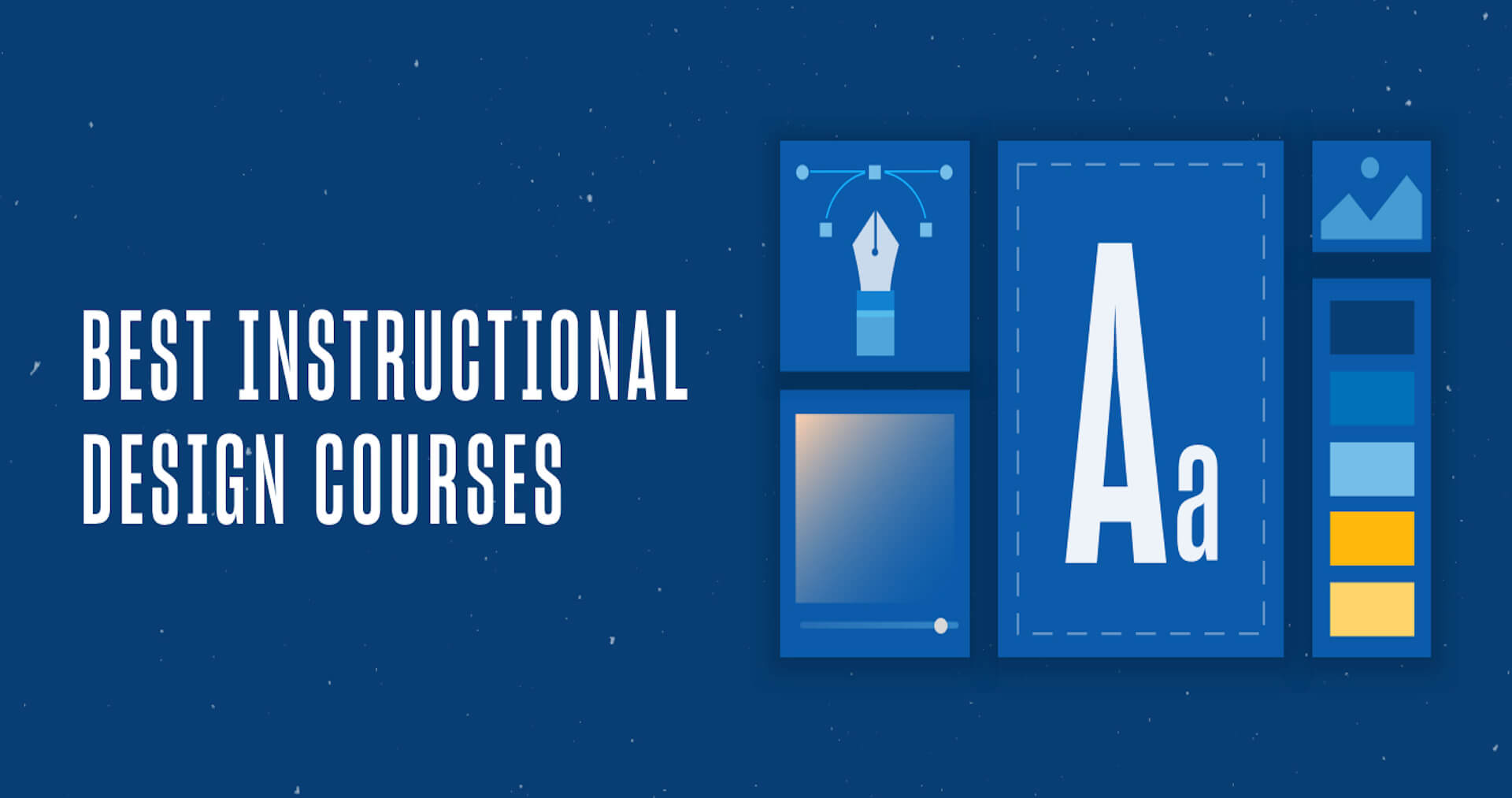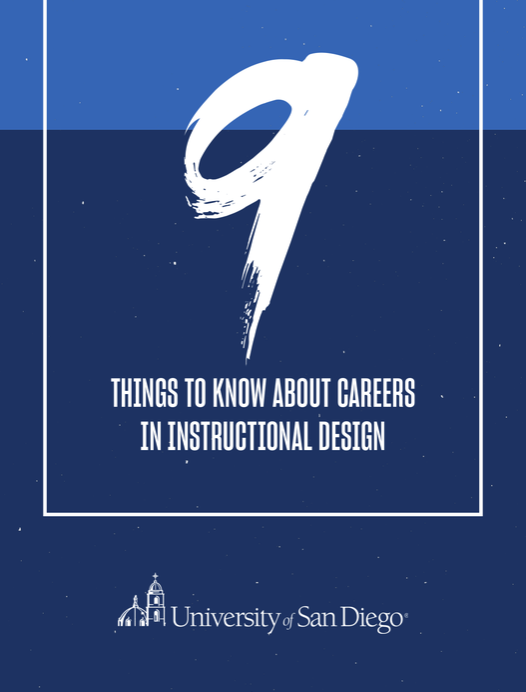If you’re interested in getting into the growing and in-demand field of Instructional Design, then you likely have some questions about what you need in terms of skills, knowledge and experience. It can feel overwhelming, since instructional and learning designers wear a lot of hats and they’re expected to be skilled in learning sciences, visual design, project management, communication, writing and other areas.
There are an increasing number of certificate and master’s degree programs that offer a range of experiences — from a foundational knowledge of theory to working with specific tools and technology. Consider this guide a highlight of the most important areas of study and the types of instructional and eLearning design courses you should be looking for in your training as an instructional designer.
Instructional Design vs. Learning Design vs. Curriculum Design
Before we cover the major areas of instructional design training or learning design courses, it’s important to define and discuss what we mean when we talk about different processes and job titles.
- Instructional design is the process of creating learning or instructional experiences that facilitate the acquisition of new knowledge. Instructional design focuses on the teaching activity — the instruction — of how content is delivered to achieve set learning goals. Instructional design practices aim to create teaching exercises that ensure the best possible outcomes for learners.
- Learning design is an evolution of instructional design that shifts the focus from the instruction of material more toward the recipient, i.e. the learner. It combines instructional design and design thinking to promote a more human-centered and creative thinking approach to learning solutions. A learning designer will take a learner’s prior experiences and current needs as the guide in coordination with appropriate learning theories.
- Curriculum Design is more about the creation of the overall course blueprint. Its focus is on how to map content to learning objectives by developing a course outline to build the course. A dedicated curriculum designer is generally less concerned with the learners or the instructional approach and is more focused on developing the actual learning materials and how they interact with or build upon each other — both within a single course and across a wider curriculum.
All three processes are intertwined, to the point that learning design and instructional design are sometimes used interchangeably, though there are important distinctions between the two. You can think of instructional design as the essential process and theories, while learning design asks “yes, and…?” to push you to think creatively about how to best empathize with your learners’ needs.
Some job positions may prioritize the specific skills and experience of one tract over another, such as an institution that’s seeking both a curriculum developer and a learning strategist to fill different roles. It’s good practice to at least familiarize yourself with all three design processes, as they encompass necessary knowledge and skills for any aspiring instructional designer.
[RELATED RESOURCE] Interested in instructional design? See how the right courses can advance your career.
Instructional Design Course Areas
Many courses are available in-person and online, each with varying names, credit hours, prerequisites, and lengths. The courses you choose will heavily depend on course availability, your schedule, the career path you want, and other variables.
So, rather than highlighting a specific instructional design course, this is a list of courses regarded as integral and fundamental to the instructional and learning design field – from understanding design theories to practical experience with specific design platforms and technological tools.
When exploring higher education opportunities, these are the courses that you’ll want to look for.
1. Instructional & Learning Design Models & Theories
If you’re entirely new to the field of learning instructional design and can’t tell the difference between an ADDIE model and the SAM model, then your education needs to start here. Many educational and training programs will offer introductory courses along the lines of “Introduction to Instructional Design” or “Learning Theory and Design.”
These programs explain the methodology of learning design, which is the process by which you “do” instructional design. They offer courses that review learning theories and instructional design models that will inform the decisions you make about designing experiences and developing materials.
If you have experience in instructional design, then taking an advanced course in theory and design, or earning a certificate that provides more hands-on experience with a specific learning model, can keep your skills up-to-date and provide you with more tools to draw upon.
2. Design Technologies and Tools
Modern instructional design utilizes numerous technologies and software to design courses, evaluate them and collaborate with others throughout the process. As an instructional designer, clients expect you to be familiar with several tools and platforms, such as Articulate Storyline, Adobe Captivate, Blackboard, and Canvas. While your program of study will likely focus on using particular platforms, you should at least be familiar with the most common and popular tools.
Standard titles for these instructional design training courses can include “Learning Technologies Foundations and Applications,” “Learning Media Design,” or specialized certificates for a particular program — i.e. “Get Started with Articulate Storyline 360.” These courses may also review basic principles of HTML coding, website design, and storyboarding.
3. Project Management
Instructional design requires careful management of your own time and your collaboration with others to complete projects on time and under budget. Courses that teach project management will provide a methodology for applying your skills to achieve your goals more effectively. These skills include aligning project work with instructional goals and learning objectives, determining a scope of work, making accurate time and cost estimates, keeping yourself and others on task, and communicating project plans with clients and other stakeholders.
Project management skills can be incorporated into more extensive “Introductory” courses, but some programs may also offer specific “Project Management for Instructional Designers,” or “Project Management” learning design courses. In general, you’ll be expected to design and develop a learning experience while performing essential project management techniques, such as aligning objectives, creating a plan, performing task analysis, and making formative and summative assessments.
4. User Design
It’s essential for instructional designers to understand the artistic and technical aspects necessary for creating engaging and accessible digital media. Courses in user design teach basic principles of user experience (UX), user interface (UI), how to follow standard web content accessibility guidelines, and how to understand and develop learner experience (LX) design rubrics.
Look for course names such as “Mastering Design Thinking,” “Visual Design Principles,” or “Elements of User Interface Design.”
5. Emerging Technologies
Some programs offer a deeper dive into emerging technologies and digital learning experiences. These courses inform students about the latest digital resources and model how to utilize them in course creation and implementation.
Courses can include topics such as “Gamification,” “Digital Storytelling,” and “Extended Reality,” or introduce digital methods of recognizing learning outcomes such as micro-credentialing and badging.
6. Content Curation
Online courses utilize digital resources and reach a broader array of students, but digital content curation requires a thoughtful approach that accounts for issues of accessibility and inclusivity excellence. Courses covering these topics may also review resources and strategies applicable to education and training, such as Open Educational Resources (OER), Creative Commons (CC) licensing, and Universal Design for Learning (UDL).
To be better prepared for tomorrow’s learning environment, look for courses on how to create online courses and utilize digital content aligned with current best practices, accessibility laws, ethical design considerations, and account for current adaptive and assistive technologies. Sample courses can include “Inclusive Design” or “Designing for Accessibility.”
[FREE GUIDE] Want to grow your skills? Learn how instructional design courses set you up for success.
7. Research Methods
Finding the information and resources you need is an important skill for any professional, but it’s essential for instructional and learning designers. IDs are expected to know how to collect and analyze data in a manner that is ethical and objective. Courses on research methods will demonstrate how to find and use data to inform program and instructional design decisions, pose research questions, and write research proposals.
Courses such as “Educational Research Methods” and “Research Methods for Instructional Design” will have students practice quantitative and qualitative research methodologies while reviewing literature specific to research in education.
8. Leadership
Instructional design courses in leadership help students develop the knowledge, practice, and communication skills required to effectively manage project expectations and deliverables while collaborating with a cross-functional design team. More courses are looking at leadership in the digital space and can include an overview of how designers can start new initiatives or lead change within an organization.
Leadership courses can focus on various elements, ranging from remote leadership techniques to a review of the governing bodies that regulate compliance with accreditation and accessibility standards.
9. Program Design, Assessment and Evaluation
While full-time programs are likely to include assessment and evaluation as a general part of their instructional design training, some programs will have dedicated courses or certificates to introduce students to the theories and techniques used in evaluating educational and training programs.
These courses will teach you the methodologies used to identify needs, establish objectives, evaluate outcomes, and then apply them in education, industry, or adult training environments. Courses like “Assessment for Learning” or “Evaluation for Instructional Design” ask students to turn theory into practice by assessing and evaluating case studies or training programs they design.
10. eLearning
Remote and digital learning is increasingly a core component of education and training. Courses in eLearning design include accounting for a variety of learning needs, effectively employing interactive elements, and learning essential authoring tools and other development software.
Courses, such as “Teaching Online” and “Interactive eLearning and Assessment,” include best practices in developing synchronous or asynchronous experiences in an online learning environment.
How to Select the Best Instructional Design Programs
The best approach toward selecting the instructional design courses depends on your own background and knowledge:
- If you’re looking to get a start in the field, then you’d be better served by a program that introduces you to the essential learning design models and theories and provides some training on all of the above areas. While you could take different courses to self-design your own program, enrolling in a structured program would offer the comprehensive instruction that will provide you with a solid base of knowledge in combination with important technical and design skills.
- If you’re transitioning into instructional design from an educational or training career and are familiar with some of the core concepts, then you may be better suited to an advanced program. These learning design programs are structured around having students apply theoretical concepts with practical applications of technology integration and collaboration.
- If you’re an existing instructional designer that wants to improve your skills and learn new technologies, then enrolling in single courses or earning specific certificates might be more appropriate for what you’re looking for.
In all cases, to ensure a strong background and portfolio, look for programs that:
- Cover the foundational models and theories of learning design
- Offer design practice through a robust implementation of modern learning technology
- Present the current trends, issues and practices in the field
- Emphasize the importance of data collection and analysis to inform design
- Prioritize inclusivity excellence in audience and cultural understanding
Finally, and perhaps most importantly, you want to look for programs that provide an opportunity to build out your professional portfolio. Having a robust set of examples of your design skills, technical knowledge and collaboration abilities will make you a strong candidate for any position. Your portfolio should highlight your struggles and mistakes as much as your successes to showcase your ability to grow, adapt and adjust to challenges.
Choosing the right instructional design courses will not only provide you with strong foundational knowledge and valuable skills and experience, but it will also make you part of a community of learners that you can draw upon for support throughout your professional career.
Those values have informed our design of the Master of Science in Learning Design and Technology program for the University of San Diego. The MS-LDT program was developed to provide our students a supportive and collaborative environment to practice their skills in developing an exemplary, peer-evaluated portfolio.
For details on the specific courses our program offers, see our curriculum page. If you have additional questions please contact us to learn more about our program.



![Preview image of What is Instructional Design? [5 Examples + Overview]](https://onlinedegrees.sandiego.edu/wp-content/uploads/2021/08/ldt_blog_whatisid-1024x576.png)
![What Does an Instructional Designer Do? [Career Info & FAQs]](https://onlinedegrees.sandiego.edu/wp-content/uploads/2021/08/ldt_blog_whatdoesiddo-1024x576.png)
![Top 10 Instructional Design Careers [+ Salary Guide]](https://onlinedegrees.sandiego.edu/wp-content/uploads/2022/03/ldt_blog_top10idcareers-1024x576.png)